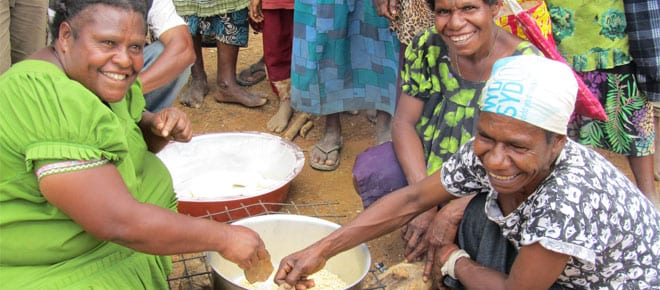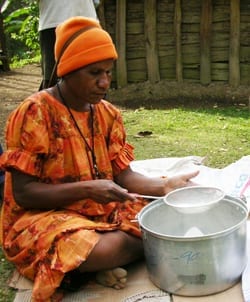Cassava is a staple crop across many parts of the world. It’s used much like a potato and admired for its versatility in cooking and as animal feed and firewood.

Cassava is a staple crop across many parts of the world. It’s used much like a potato and admired for its versatility in cooking and as animal feed and firewood.
In the Pacific it trails sweet potato, yams and taro in popularity, so raw or dried cassava fetches a low price at market. Fewer people grow this carb-rich crop, but Oxfam partner Community Development Agency (CDA) is opening the eyes of farmers in Bokolma Sulma to its advantages.
By adopting a West African technique, they are changing the tuber into something special, something that is transforming the local economy, providing people with food security and diversifying their diets.
From simple roots

Papua New Guinea’s Highlands are blessed with the perfect tropical climate and soil for cultivating cassava.
It’s proven favourable with farmers because it is drought tolerant, easy to grow, requires little weeding and is simple to harvest.
After unearthing the tubers, families in Papua New Guinea have traditionally prepared the cassava tuber by boiling it then eating it whole. Cassava tubers decay a few days after being unearthed so a crop doesn’t last long before it must be eaten. Very few people generate any income from selling their crop.
Willing milling
But there is a way to preserve the cassava and elevate the raw tuber into something more versatile, longer-lasting and tasty.
CDA members are teaching people step-by-step how to develop the raw tuber into flour, following the process commonly used across sub-Saharan Africa.
The cassava tuber is first peeled and washed to rid it of any impurities. It’s then ground to mash in milling drums and placed into a sack which is pressed to remove excess water, resulting in a crumbly mixture reading for drying in the sun. Once it’s developed into a powdery substance it is sifted and ready for use as cassava flour.
This flour can be used to make dough for baking bread, cakes and biscuits.
Flour power

The flour is incredibly popular. Women bake fufu (cassava bread) and cakes and sell them at market or along roadsides. Diets in this part of Papua New Guinea are generally limited so these treats are really valued.
Baked goods reach a much higher price at market and the money these women earn is used to feed and clothe their children, pay for house repairs or reinvested back into cassava growing.
CDA is supporting a thriving cottage industry that has spun up as a result of the flour’s popularity – they are helping people to make their own cassava milling drums and sell them on to families who want to produce their own flour.
And turning the cassava roots into flour maximises the life of the crop. The flour can easily be stored for up to a year and is ready to use when natural disasters like flooding strike. The reliable reserve of flour provides Bokolma Sulma with a food security that lacked before CDA’s involvement.



